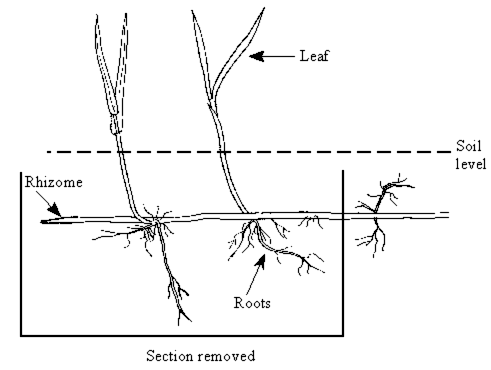Couch - A type of grass

A rhizome is a long horizontal, underground stem.
| Y8 (10/2005) | ||
|
a) |
If any section of the rhizome is left in the soil, a new plant can grow making it hard to get rid of. Or A rhizome grows horizontally and spreads a long way, therefore being hard to remove without leaving parts of roots and rhizome in the soil. |
difficult |
| b) | The section remaining may give rise to another plant/some roots are left. | moderate |
| c) | If the rhizome is cut, each section still has food-making and water-absorbing parts (i.e., ensuring survival). | very difficult |
For question a) common errors/misconceptions were
- The plant would be difficult to get rid of because the roots were under the rhizome. Many students perceived the rhizome as an impenetrable barrier rather than the fact that the horizontal and 'spreading' nature of the rhizome ensures it is more difficult to get rid of.
- There was insufficient detail in the response. For example: "because of the rhizome"; "because of the root"; "because of the way it grows".
For question c) common errors/misconceptions were:
- Most students did not appear to understand, or have the background knowledge about, the methods by which plants receive food and moisture, so further work on the function of plant roots and leaves may be necessary.
Rhizomes are usually underground, horizontal stems of a plant. They often send out roots and shoots from their nodes. They are also referred to as creeping rootstalks, or rootstocks. They act as a food store for plants and help to spread the plant by asexual reproduction. Other examples from the flowering plants are asparagus and lily of the valley. The spreading stems of ferns are also called rhizomes.
Next steps
Explore asexual methods of reproduction, such as rhizomes, bulbs, corms, tubers and runners. Asexual reproduction is a Level 5 objective, so only an introduction to the idea is needed, that some plants can grow from 'bits' other than seeds. Students need this bit of information to be able to understand that this feature enables some plants to compete aggressively with others.
Ministry of Education (1999). Making Better Sense of the Living World.. Wellington: Learning Media Limited. See Roving Roots, Meandering Plants, Activities 6 & 7, p. 57.
Ministry of Education (2002). Building Science Concepts Book 26. Making New Plants. Wellington: Learning Media Limited.
Another ARB on plant pests is Kahili ginger (wild ginger)
Other ARB resources on roots:

